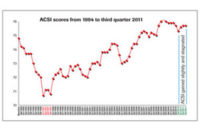Food safety, economy dictate consumer food choices

Consumer confidence in food safety has risen in five years, and grocery stores are generally more trusted than restaurants for having safe food.
Consumer confidence in food safety is the highest it’s been in seven years, according to a study from the Food Marketing Institute (FMI). According to the report, US Grocery Shopper Trends, 88 percent of shoppers are completely or somewhat confident in the safety of food at the supermarket.
More than 90 percent of shoppers either strongly or somewhat believe their grocery stores are doing their part to ensure the food they eat is safe. Processors, however, don’t quite measure up. When asked where they believe food safety breaches occur, more than half of shoppers named food processing and manufacturing plants.
However, when respondents were asked who is responsible for ensuring food safety, more than half (58 percent) of respondents said they are responsible for the safety of their food, up seven points from 2010. Next on the list are manufacturers and processors at 35 percent, followed by supermarkets and government agencies at 28 percent each, says the study.
According to the report, consumers continue to be most comfortable with food grown in the US versus imported products. Shoppers who are either very or somewhat comfortable with US food safety numbered 97 percent. The survey found that 76 percent of men are comfortable with imported food from Latin and South America, while 58 percent of women feel comfortable with imported food from the same areas. The survey also found that younger consumers are much more comfortable with imported foods compared to shoppers aged 65 or older.
While 2011 so far has been a year without many high-profile food recalls, consumer confidence in food safety is greatly affected by recall activity, says the report. Today’s technology is making it easier for food manufacturers and retailers to communicate food recall announcements quickly to a broad audience.
Besides food safety, healthy eating is another concern, and nutrition labeling programs are helping consumers make informed choices. However, only 29 percent of those surveyed consider themselves very knowledgeable in the area of nutrition, and nearly half (49 percent) say they are not expert in this area. Only 17 percent, however, admit they could use some help in understanding nutrition labeling information, says the study.
An overwhelming 90 percent of those surveyed believe home-cooked meals are healthier and more affordable than restaurant meals. The vast majority of consumers (82 percent) say they are responsible for ensuring the food they eat is nutritious. Others place the responsibility on food manufacturers and processors (48 percent), government agencies (30 percent) and supermarkets (29 percent).
Rising fuel costs, higher commodity prices and increasing international market demand for food are pushing food prices higher and higher. While these costs directly affect processors, they are causing consumers to rethink purchases. As a result, the number of trips consumers make to buy groceries has dropped to an average of 1.69 trips per week, the lowest level in the 37-year history of the study. People shopping for groceries only once a week rose from 29 percent to 34 percent, and those shopping once every other week increased from 12 to 20 percent, according to the study.
The study also found the majority of shoppers drive less than five miles to their primary store, but 60 percent do not shop for groceries nearest or most convenient to their home. Two-thirds say the one reason they bypass the closest store is to seek lower prices. Nine in 10 consumers visit a full-service supermarket at least once a month, while nearly 60 percent visit a supercenter once a month, followed by warehouse club stores (27 percent).
Whether it’s the quest for healthier food or shorter distance, consumers continue to show strong support for locally grown products, with as many as four out of five saying they occasionally purchase these products. The definition of local is, however, is up for grabs, with almost an equal number of people saying it’s within state lines (44 percent) and those who say it’s a certain number of miles (41 percent).
In spite of any inconveniences, consumers’ commitment to sustainability is still growing, especially with behaviors that require little consumer sacrifice. Compared to 2008, plastic recycling rose from 62 to 75 percent in 2011, paper from 63 to 74 percent and cans from 70 to 78 percent.
For more information on the study, visit www.fmi.org.
Looking for a reprint of this article?
From high-res PDFs to custom plaques, order your copy today!






